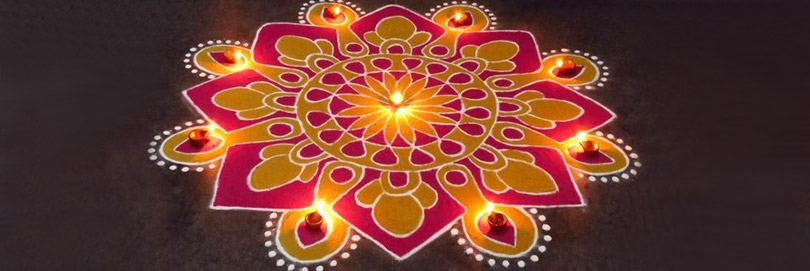The Tradition of Rangoli

Rangoli is an Indian traditional or folk art, which is generally created on the floor on some festive occasions. The Indian scriptures and puranas (hindu mythological literature works) can be attributed for the emergence of this creative rangoli art. This ancient Indian art is believed to be originated from the Indian state Maharashtra, from where it get gradually dispersed in the rest of the country.
Rangoli is named differently in different Indian states like in South India it is called Kolam, Madana is Rajasthan, Chowkpurna is the name of rangoli in Northern India, Alpana in Bengal, in Bihar it is called Aripana, and so. According to the earliest disquisition or treatise on Indian painting, named Chitra Lakshana, a king and his kingdom were extremely grieved on the death of the high priest's son. Everybody along the king offered prayers to the creator of the universe, i.e, Lord Brahma for giving life to the boy. Brahmaji, being moved by the prayers of these people, came and asked the king to paint a likeness of the dead boy on the floor. He then put life into the portrait, thus relieved the entire kingdom from its sorrow and pain. This mythological tail is considered the scriptural evidence of the origin of this beautiful Hindu art, named Rangoli.
Rangoli as a Creative Expression'Rangoli' is a Sanskrit word, signifying a creative expression of art by means of colors. In ancient times, beautiful rangoli patterns and designs were made on the entrances of Indian homes for beautifying them and welcoming the guests. Besides a creative expression of art, they were also considered a symbol of good-luck. Ours is the culture of, “Athiti Devo Bhava” means “Guest is God”. So, what can be better than rangoli in expressing this cultural mannerism and hospitality that we possess by tradition. Although rangoli is made on many occasions in India, but the Diwali festival witnesses the greatest use of rangoli. People made rangoli on the entrance doors of their homes on the auspicious occasion of Diwali, not only to welcome guests, but goddess Laxmi (the goddess of wealth and fortune).
The formation of an ideal rangoli art demands the attentive use of vibrant rangoli colors on a properly broomed and cleaned floor. However, rangolis are simple two-dimensional designs, but even the modern three dimensional art becomes graceless before them. Freehand use of vivid colored powders is made while making a rangoli. The most common way of making a rangoli is to pinch the thumb and the forefinger and let the color to freely run out from the gap.
Rangoli was one of the major decorations or embellishments in the ancient times, but they have not lost their charm even in the modern context. These traditional embellishments are still used in India on various festivals and special occasions like marriages, birth ceremonies, and so. Although rangoli making is a popular art across India, but they are like a tradition in Maharashtra, where they are most prevalent. On the Diwali festival, people usually make various types of geometrical patterns and designs between which they place oil lamps (diyas).
- - Diwali Cards
- - Crackers
- - Dry Fruits
Festival Fun
- Diwali Rangoli
- Diwali Whatsapp Messages/Status
- Diwali Recipes
- Deep in Diwali
- Tradition of Playing Cards
- Pooja Thali Decorations
- Making Diwali Cards
- Diwali Essay
- Diwali Poems
- Diwali Songs
- Diwali Mela
- Diwali Wallpapers
- Diwali Decorative Items
- Diwali 2024
- Diwali Messages
- Diwali Quotes
- Lakshmi Pooja
- Articles
- Lakshmi Ganesha Mantras
- Lakshmi Chalisa
- Diwali SMS
- Diwali Solar Eclipse
- Diwali Remedies
- 108 Lakshmi Names
Diwali Rangoli
Indians love colors and its perfectly reflected in various ways. Rangoli is one such example that is a unique art work that is...Know More
Diwali in History
The history of Diwali is replete with legends and these legends are moored to the stories of Hindu religious scriptures...Know More
Diwali Messages
Enjoy the Best and the Most Heartfelt Diwali Messages from all entries received by us!!...Know More
Diwali Gift Ideas
Diwali is the epiphany of showing gratefulness to the almighty for blessing with wealth and wisdom. It is the time of illuminating...Know More





